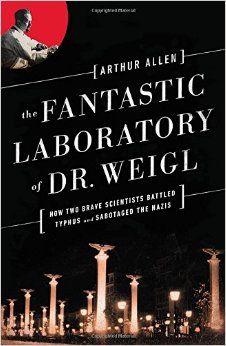Medical Miracles in Wartime
December 19, 2014 in Library Corner
Today we worry about Ebola. During World War II, the disease to dread was typhus, which ran rampant through vulnerable populations. Anne Frank and her sister Margot were among 17,000 inmates at Bergen-Belsen who succumbed to typhus in the final weeks of the war.
Two Polish typhus researchers, one Aryan and one Jewish, deserve recognition as World War II heroes, according to science journalist Arthur Allen. The intertwined stories of Drs. Rudolf Weigl and Ludwik Fleck are the subject of Allen’s latest book, The Fantastic Laboratory of Dr. Weigl: How Two Brave Scientists Battled Typhus and Sabotaged the Nazis.
Typhus, Lice, and Jews
Typhus is a bacterial disease spread by body lice (not head lice). Historically, such lice afflict encamped soldiers, prisoners, and others living in cramped, unsanitary conditions. Yet, in Nazi racial ideology, typhus was a “Jewish disease.” As Allen writes in The Fantastic Laboratory, “The louse, carrier of typhus, was the symbol of the Jew . . . a filthy, parasitic, blood-sucking disease vector that had penetrated the German nation.” In fact, the Nazi pseudo-scientific pretext for isolating Jews in locked ghettos was to contain typhus and prevent Jews from infecting Aryans. As the Nazis sealed the Warsaw ghetto, they pasted posters around the city showing an ugly, bearded Jew with a huge louse and the menacing caption, “Jews-Lice-Typhus.”
Concentration camps took measures to prevent typhus, not out of concern for the prisoners, but to protect Germans from the disease. Guards herded incoming prisoners through disinfection rooms to be stripped, shaved, and doused in caustic chemicals intended to kill lice. Routine disinfection also provided cover for more diabolical Nazi schemes; countless prisoners dutifully undressed for “shower rooms” that were actually gas chambers.
Weigl’s Vaccine
Rudolf Weigl (1883-1957) began studying typhus and lice while serving as a medic in the Austro-Hungarian army during World War I. Back home in Poland, he continued his research, developing the first effective vaccine in the 1930s. When World War II began, Germany courted Weigl (who was ethnically German) with offers of a university chair in Berlin, sponsorship for the Nobel Prize, and privileged status as an Aryan. Rejecting the offers, Weigl declared his loyalty to Poland.
Eventually, the Nazis seized Weigl’s laboratory and demanded typhus vaccines for German troops. Torn between suicide and cooperation, Weigl chose cooperation, says Allen, “on his own terms.” While serving the Reich, Weigl secretly smuggled thousands of doses of vaccine to desperate Jewish ghettos. Moreover, he sheltered as many as 3,000 Polish intellectuals wanted by the Nazis by employing them in his laboratory.
Philosopher, Scientist Fleck
As a young man, Ludwik Fleck (1896-1961) assisted Weigl with typhus research; later, the men’s professional paths diverged. A philosopher of science as well as a bacteriologist, Fleck was an early pioneer of the theory that so-called scientific truths are in fact shaped by their cultural context; ironically, this theory helps explain the “groupthink” of Nazi medical authorities, who deluded themselves that Jews posed a threat to public health.
In 1942, Fleck, trapped with other Jews inside a typhus-infested Polish ghetto, developed a new method for generating typhus vaccine. Eager for more vaccine than Weigl’s method could deliver, the Nazis sent Fleck to a Buchenwald research station to make typhus vaccines for the German army. Under Fleck’s guidance, the laboratory slaves daringly manufactured two types of vaccines – a fake, worthless vaccine they shipped to German troops and an effective vaccine they used to secretly immunize their fellow inmates.
A fascinating tale of science in wartime, The Fantastic Laboratory is in our library.
